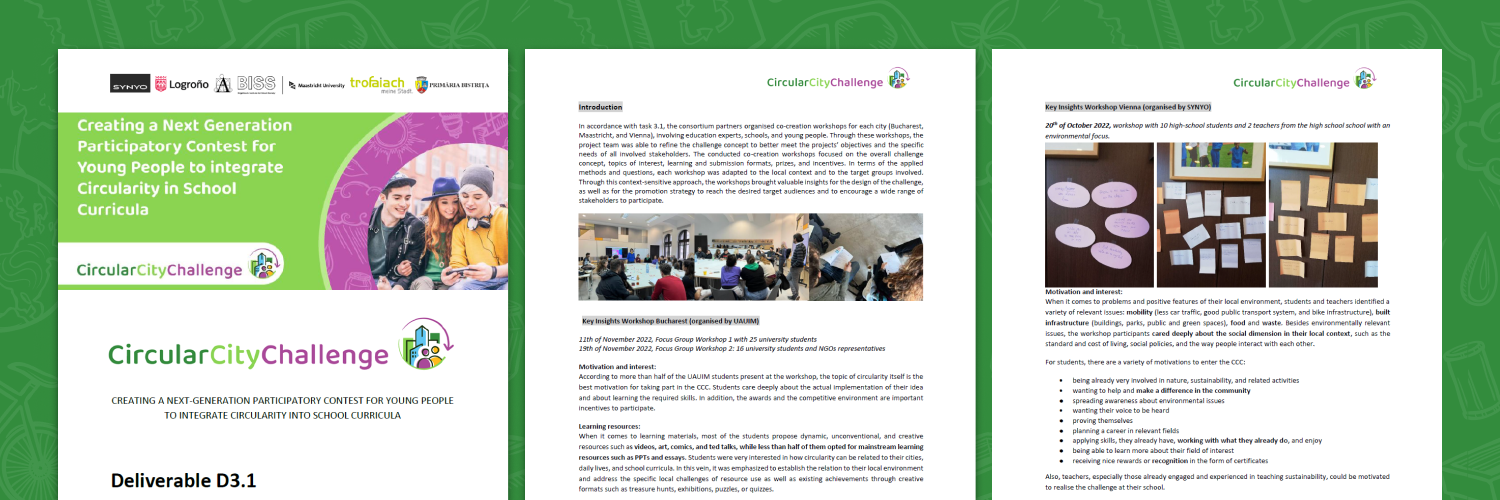
CO-CREATION WORKSHOPS

Creating the sustainability curricula for students with students
In the long term, the aim of the CCC competition is to design a new curriculum that can be used by schools and teachers to integrate sustainability and the circular economy into the curriculum on a permanent basis. But how do you design an international competition that is as inclusive as possible and at the same time offers serious criteria to be fair for all? What do the participants want, what are the obstacles and what motivates them?
To gain better insights into potential attendees of the competition, the consortium partners of CircularCityChallenge organised co-creation workshops for each city (Bucharest, Maastricht, and Vienna), involving education experts, schools, and young people. Through these workshops, the project team was able to refine the challenge concept to better meet the projects’ objectives and the specific needs of all involved stakeholders. The conducted co-creation workshops focused on the overall challenge concept, topics of interest, learning and submission formats, prizes, and incentives. In terms of the applied methods and questions, each workshop was adapted to the local context and to the target groups involved.
Interests and motivations
The motivation to participate in the competition was not driven by prizes or money: Most participants were not only driven extrinsically (receiving monetary recognition and benefits for their future success and professional career) but also very much intrinsically. They cared deeply about what is happening in their environment and globally while interacting and exploring the unknown lies at the centre of their interests. In fact, the topic of circularity itself is the best motivation for taking part in the CCC. In addition, students wished to be heard, to be taken seriously, and to contribute to climate action themselves. In this regard, the general concept of supporting circular projects and promoting exchange with like-minded peers and local actors was positively received.
Learning resources
When it comes to learning materials, most of the students propose dynamic, unconventional, and creative resources such as videos, art, comics, and ted talks, while fewer students opted for mainstream learning resources such as PPTs and essays.
However, for students to not be discouraged from the challenge, the often quite overwhelming topics of sustainability and circular cities need to be broken down into small, practical, and simple issues. In this vein, the focus on problems and solutions in the students’ local environment is helpful to make the topic practical and relatable.
Barriers, Issues and considerations
In addition, impediments to successful participation could be identified, which need to be addressed in the contest design. Students expressed doubt about teachers’ motivation and ability to engage in circular teaching beyond the existing curricula due to lack of time, the extent of obligatory content to teach, and the difficulty of creating interdisciplinary cooperation between teachers. To address these issues, it was proposed that teachers receive personnel support on a regular basis so that involvement in such teaching activities is possible without extra work.
Certain structural burdens could also limit the possibility to invest time and effort beyond the school curricula. Important will be to
• connect the competition to the existing curricula,
• clear communication about the contest,
• easy access for the students,
• sufficient support for the teachers.
Summary
Overall, the workshops revealed a high awareness of sustainability among the youth and a strong interest in engaging in educational competitions such as the CircularCityChallenge. They wish to be heard, to be taken seriously, and to contribute to climate action themselves. In this regard, the general concept of supporting circular projects and promoting exchange with like-minded peers and local actors was positively received. However, also impediments to successful participation could be identified, which need to be addressed in the contest design. Structural burdens limit the possibility to invest time and effort beyond the school curricula. Besides connecting the competition to the existing curricula and teaching activities, clear communication, easy access, and sufficient support will be vital. For the competition to be inclusive and an empowering experience for the participants, its design needs to account for the everyday realities of all involved stakeholders, in different school settings and regional typologies.
